Human Cough Virus Particles in the Coffee Shop, CFD Simulation Ansys Fluent Training
$120.00 Student Discount
- The problem numerically simulates Human Cough Virus Particles in the Coffee Shop using ANSYS Fluent software.
- We design the 3-D model by the Design Modeler software.
- We Mesh the model by ANSYS Meshing software, and the element number equals 4578388.
- We perform this simulation as unsteady (Transient).
- We use the discrete phase model (DPM) to define virus particles.
- We define an Injection as the Droplet which will be evaporated.
- We use the Species Transport model to define evaporating gas.
To Order Your Project or benefit from a CFD consultation, contact our experts via email ([email protected]), online support tab, or WhatsApp at +44 7443 197273.
There are some Free Products to check our service quality.
If you want the training video in another language instead of English, ask it via [email protected] after you buy the product.
Description
Description
The problem simulates the Human Cough Virus Particles in the Coffee Shop using ANSYS Fluent software. We perform this CFD project and investigate it by CFD analysis.
The present model is designed in three dimensions using Design Modeler software. The model’s geometry includes a computational domain of the interior of a coffee shop.
The meshing of this present model has been generated by Ansys Meshing software. The mesh grid is unstructured, and the curvature method focuses on grid-sensitive areas. The total cell number is 4578388.
Also, due to the nature of the present problem, the transient solver has been enabled.
Human Cough Methodology
In this Project, Ansys Fluent software simulates human cough virus particles in the coffee shop using two-way DPM. According to this definition of injection, human cough virus particles are physically expelled from the patient’s mouth by water droplets evaporating in space.
These virus droplets have a temperature of 310 K, a velocity of 31.85 m/s, and a mass flow of 0.018 kg/s, which are emitted at intervals of 0s to 0.1s.
The particle diameter of the virus is not constant during propagation, and the rosin-rambler-logarithmic distribution method is considered for the size of the diameters.
Following this method and the suitable formulation, the values related to the minimum, maximum, and average diameter size determine the exponential parameter of the spread and the number of diameters per injection.
It should be noted that the drop mode is applied when the species transport model is also activated.
The boundary conditions related to the discrete phase model are defined as particles at the patient’s mouth boundary with Escape mode, which means particles passing through this boundary.
The boundaries of people’s bodies and all the walls related to the tables and chairs have a wall film mode, and for the floor, use the Trap model, which means that particles are trapped and accumulate on these surfaces.
The present simulation process is unsteady and in a time interval for 3s with time steps equal to 0.01 s.
Moreover, the RNG k-epsilon model and energy equation are enabled to solve the turbulent fluid equations and calculate temperature distribution within the domain.
Human Cough Conclusion
At the end of the solution process, we obtain the virus particle tracking at the last second of the simulation.
This particle tracking is based on residence time. We also exported the animation of the virus dispersion and its disappearance over time, showing how the particles are dispersed inside the computational domain.
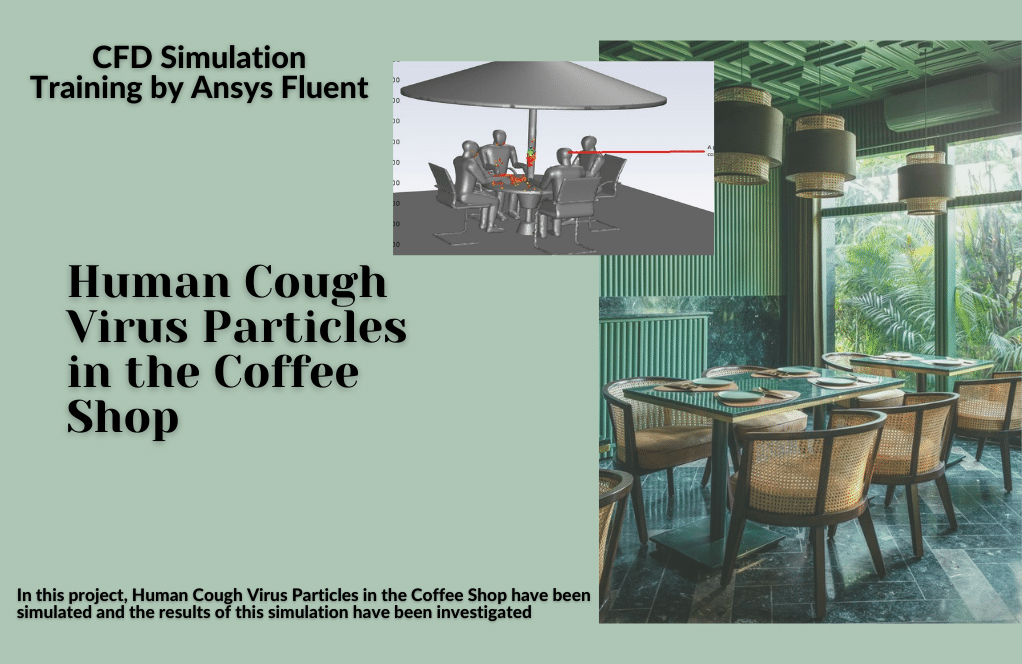
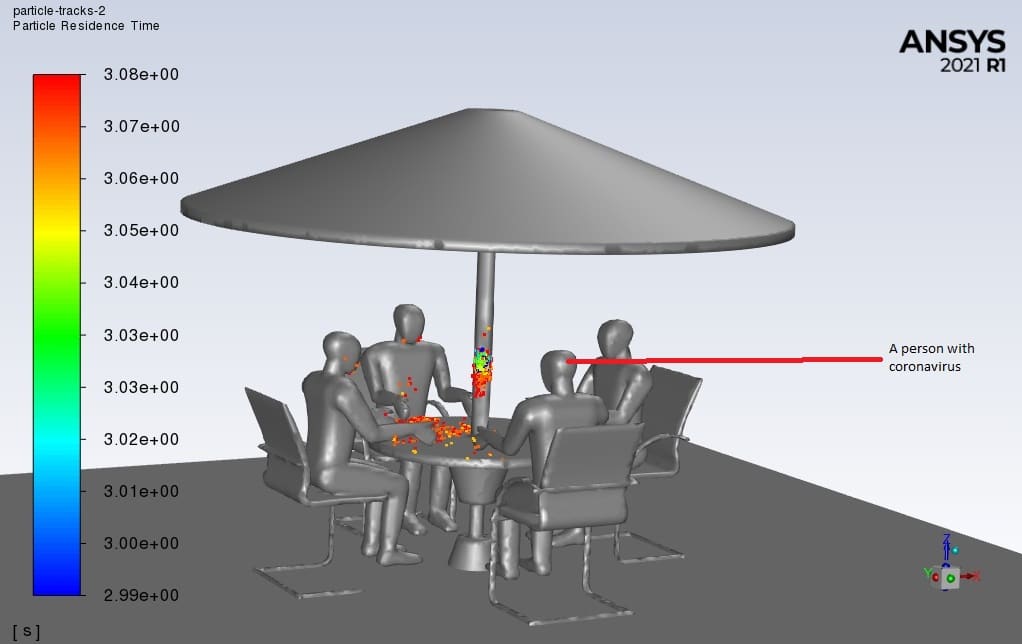
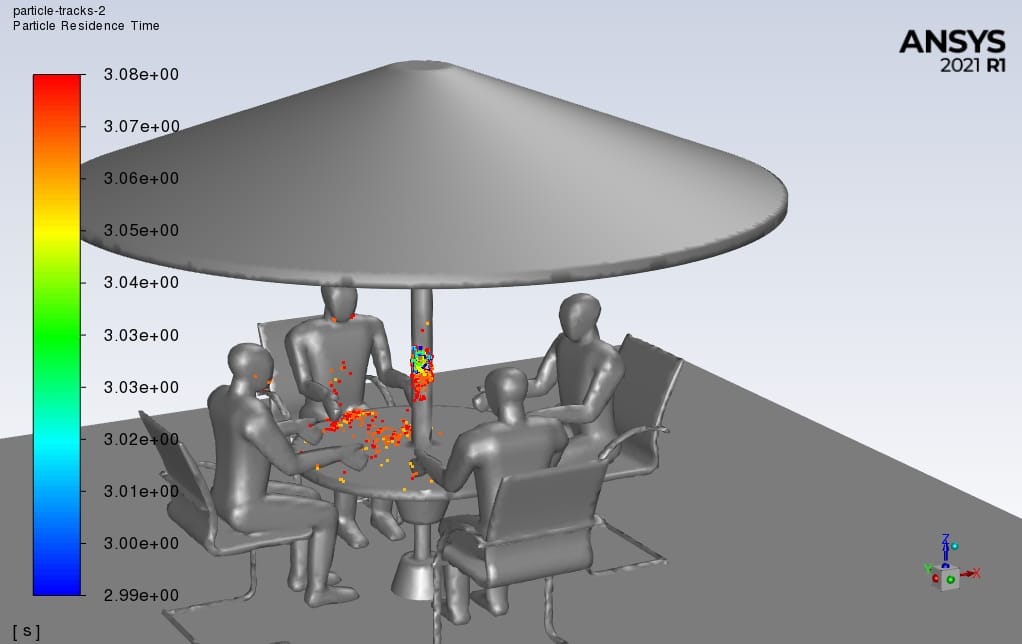

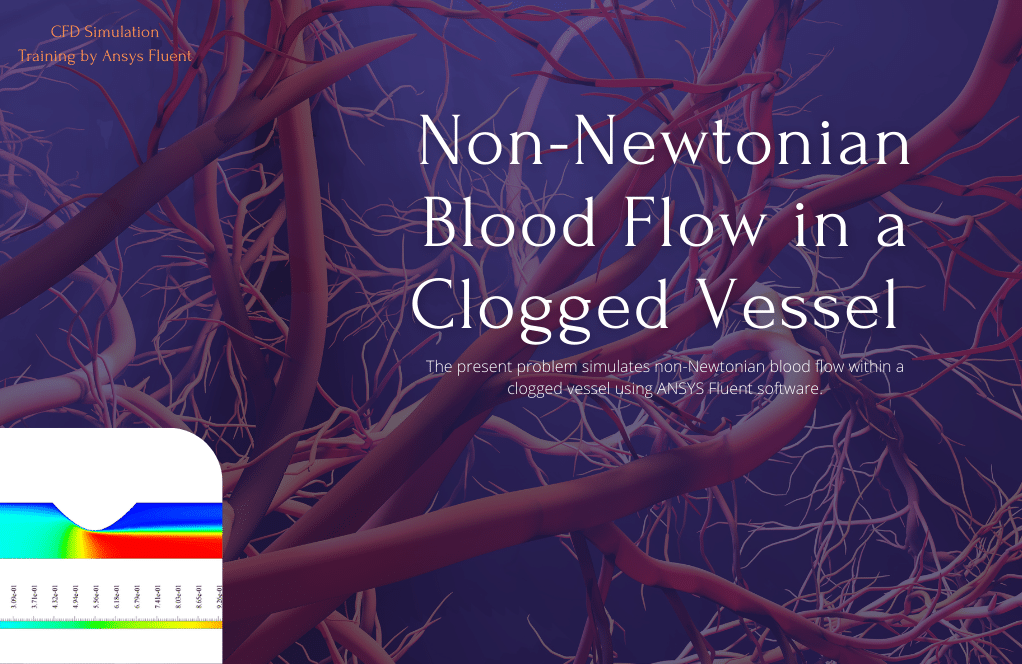
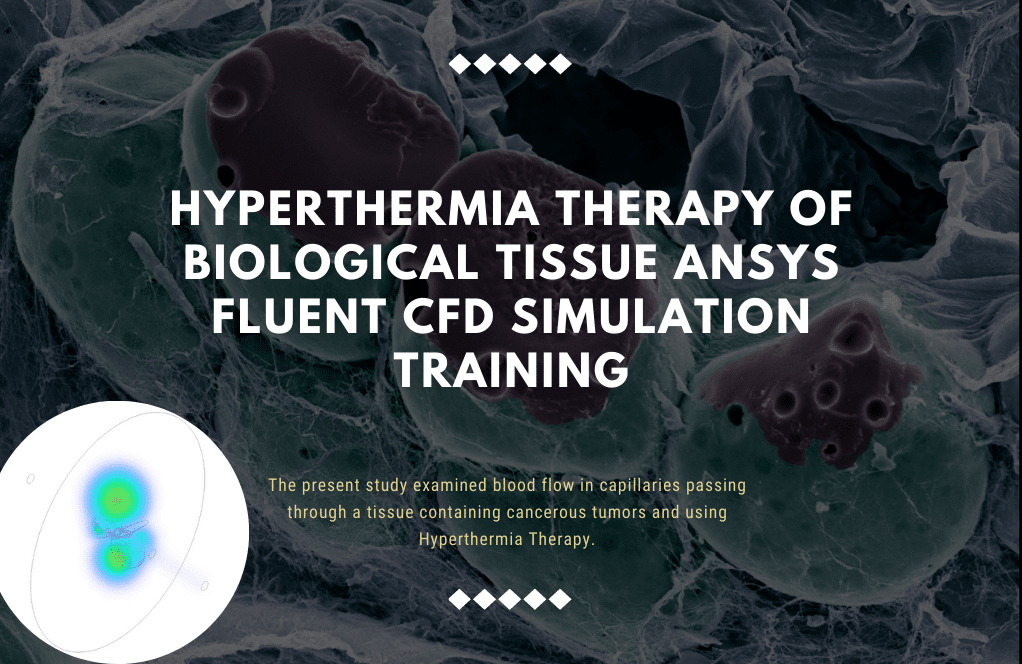
Demarcus Bogisich –
I was really impressed by the level of detail in setting up the Human Cough Virus Particles simulation. It was particularly enlightening to see how the virus spread within an indoor environment, such as a coffee shop. The use of DPM to simulate the evaporation and spread of droplets is clever. It is an excellent learning tool for understanding virus transmission in public spaces and could be very useful for improving indoor ventilation design. Great work!
MR CFD Support –
Thank you so much for your positive feedback! We’re very pleased to hear that the simulation of human cough virus particles in a coffee shop was both enlightening and useful for understanding virus transmission in public spaces. We take great care to ensure that our learning products are informative and can help with practical applications like indoor ventilation design. We appreciate your compliments and are glad that you found great value in our work!
Brielle Hill PhD –
I am extremely impressed by the detail and scope of the ‘Human Cough Virus Particles in the Coffee Shop’ simulation done by MR CFD. It is fascinating how the simulation captures the dynamics of virus particle spread in an everyday environment. The addressing of various factors like particle size distribution, evaporation, and the interaction with various surfaces provides profound insights into airborne transmission. Even the temperature and velocity of the cough were taken into account, which shows an impressive level of detail. Excellent training material for understanding the complex nature of airborne particle dispersion!
MR CFD Support –
We are truly appreciative of your kind words and delighted to hear that our ‘Human Cough Virus Particles in the Coffee Shop’ CFD simulation met your expectations. It’s great to know that the comprehensive nature and the attention to detail within the simulation provided you with valuable insights. Thank you for recognizing the efforts in creating such detailed training material. Understanding these complex phenomena is crucial, and we’re glad we could contribute to your learning experience. Thank you for choosing MR CFD for your research and study needs!
Fabian Beer –
I’m thoroughly impressed with how the simulation captures the complexities of virus particle dispersion in a coffee shop. The attention to detail, like the rosin-rambler-logarithmic distribution for particle size distribution and the RNG k-epsilon model for turbulence, really makes a difference in the realism of the simulation!
MR CFD Support –
Thank you for your kind words! We are delighted to hear that you appreciate the level of detail and realism in our CFD simulation of virus particle dispersion in a coffee shop. Our aim is always to provide precise and useful analytics that can aid in understanding complex flows like aerosol spreading. If you have any further questions, we’re here to help!
Vergie Greenfelder –
I’ve always wondered if different temperatures in the coffee shop would make a difference in the virus particle dispersion. Can you simulate different temperature scenarios?
MR CFD Support –
Yes, temperature can significantly affect particle dispersion due to thermal effects and air currents. We can indeed conduct simulations at varying temperatures to see how these changes might influence the behavior of virus particles in the coffee shop environment. The energy equation is enabled in this scenario, which allows us to modify the temperatures and observe the impact on virus dispersion.
Brad Shields –
I found the explanation of the cough spread simulation very fascinating. It clearly illustrates the importance of airflow and particle dynamics understanding in public health and air quality. Great work!
MR CFD Support –
Thank you for your positive feedback! We’re pleased to hear that you found the human cough virus particle simulation in a coffee shop intriguing. Simulations like these play a crucial role in improving public health strategies. If you have any questions or need further clarifications about our product, feel free to ask!
Jaeden Jones –
I was really intrigued by how this simulation mapped out cough droplet dynamics in a coffee shop. Fantastic detail on the spread and evaporation of droplets! Has this model been validated against experimental or real-world data?
MR CFD Support –
Thank you for your kind words and insightful question! Our simulation relies on accurate physical models and computational methods; however, specific validation details against experimental benchmarks or field data for the simulations of cough droplet dynamics in this context would require specialized studies. We continuously aim to enhance the accuracy of our models, and validation with real-world data would be a significant part of that process where possible.
Mr. Santino Sipes DDS –
The CFD simulation of virus particles spread in a coffee shop seems very detailed! Was the interaction between the airborne particles and the shop’s ventilation system also considered in this model?
MR CFD Support –
Thank you for your appreciative words and your interesting question! However, the provided data does not explicitly mention the coffee shop’s ventilation system. This simulation focuses on the spread of virus particles emitted through human cough and factors in gravity, evaporation, and air turbulence, as described. For specific insights into the ventilation interactions, additional simulation settings and data would be required, which might not be included in the current scope but could be an excellent consideration for future modeling.
Mervin Kuhn –
Is the coffee shop ambient temperature and air conditioning system considered in the simulation of cough virus particle dispersion?
MR CFD Support –
Yes, the ambient temperature and the air conditioning system can be taken into account to study how they might affect the dispersion and behavior of cough virus particles within the coffee shop environment. Doing so would provide a more realistic simulation of the temperature distribution and airflow patterns, which are critical factors in understanding virus spread indoors.
Timmy Huels –
What type of grid is used for the meshing in this CFD project simulation, and why was this type chosen?
MR CFD Support –
The mesh grid used in this CFD simulation of Human Cough Virus Particles in a Coffee Shop is unstructured, and a curvature method is utilized. This type of grid and method was chosen because it allows for better capture of the flow features near the body curves and complex geometries within the coffee shop, such as tables, chairs, and human figures. Moreover, the sensitivity of specific areas to grid changes due to the nature of virus dispersion necessitates a more meticulous grid arrangement, which is facilitated well by an unstructured grid.
Frederick Predovic –
The training content is incredibly in-depth and practical. It was fascinating to see how DPM and species transport model work in detailing the spread of virus particles in a real-world setting like a coffee shop. The animations and particle tracking provided a clear visual understanding of the dispersion process over time.
MR CFD Support –
Thank you for your positive feedback! We’re thrilled to hear that you found the training in-depth and practical. It’s great to know that the visual aspects, such as animations and particle tracking, significantly enhanced your understanding of the virus particle dispersion process. We appreciate you taking the time to share your experience.
Keith Feest –
The simulation seems thorough. Can you please elaborately explain how exactly the droplet evaporation process is modeled in this simulation?
MR CFD Support –
In our simulation, droplet evaporation is modeled using a detailed particle tracking model that takes into account heat and mass transfer between the droplets and the surrounding air. The model includes the latent heat of vaporization and considers ambient temperature and relative humidity. This approach helps us mimic the physical evaporation process of water droplets expelled during a human cough accurately in a coffee shop environment.
Miss Syble Koepp –
The description notes the unsteady simulation process is over a 3-second interval with 0.01-second time steps. How was the decision made to use this specific time step? Were smaller or larger steps considered for improved accuracy or computational efficiency?
MR CFD Support –
The time step of 0.01 seconds was chosen to strike a balance between accuracy and computational efficiency. It allows for capturing the transient behavior of the aerosol particles while ensuring that the simulation remains manageable in terms of computational resources and time. In transient simulations like this, time steps might be refined in preliminary testing for increased accuracy, especially if high-frequency dynamics are expected; however, smaller time steps would increase the computational cost. Larger time steps could have been deemed too coarse to capture the essential nuances of the problem dynamics.
Prof. Verlie Rippin –
This simulation of virus particle dispersion sounds fascinating. Was it also able to identify or demonstrate areas of higher concentration where viral load would be expected to be the greatest?
MR CFD Support –
Definitely! The CFD simulation includes detailed analysis of virus particle dispersion which helps to visualize areas with higher concentration of viral particles. Flow visualization techniques such as pathlines, contour maps, or vector fields are commonly used to highlight regions with elevated viral load for a comprehensive assessment of potential exposure risk within the coffee shop environment.
Ron Cassin –
The level of detail in the CFD analysis for simulating virus particle dispersion in a coffee shop is impressive, from the temperature and velocity of the viral droplets to the interaction of the virus with different surfaces. The use of Ansys Fluent’s capabilities to demonstrate the spread of viruses in real-world scenarios is remarkable and vital for understanding indoor transmission. Kudos to the team for such a comprehensive and timely study!
MR CFD Support –
Thank you for your positive review! We strive to provide comprehensive simulations that can be valuable for public health safety and are thrilled to hear that you appreciate the level of detail in our Human Cough Virus Particles simulation. If you have any further questions or need assistance with similar projects, please do not hesitate to reach out to us.